 W
WAnoa, also known as dwarf buffalo and sapiutan, are a subgenus of Bubalus comprising two species endemic to the island of Sulawesi in Indonesia: the mountain anoa and the lowland anoa. Both live in undisturbed rainforest and are similar in appearance to miniature water buffalo, weighing 150–300 kg (330–660 lb).
 W
WThe lesser sheath-tailed bat is a species of sac-winged bat in the family Emballonuridae. It is found in the Malay Peninsula, Borneo, and many other parts of the Indonesian Archipelago. It is locally threatened by habitat loss.
 W
WThe small Asian sheath-tailed bat is a species of sac-winged bat in the family Emballonuridae. It is found in Borneo, Sulawesi, and the Philippines.
 W
WThe Celebes warty pig, also called Sulawesi warty pig or Sulawesi pig, is a species in the pig genus (Sus) that lives on Sulawesi in Indonesia. It survives in most habitats and can live in altitudes of up to 2,500 m (8,000 ft). It has been domesticated and introduced to a number of other islands in Indonesia.
 W
WThe Sulawesi palm civet, also known as Sulawesi civet, musang and brown palm civet is a little-known palm civet endemic to Sulawesi. It is listed as Vulnerable on the IUCN Red List due to population decline estimated to have been more than 30% over the last three generations inferred from habitat destruction and degradation.
 W
WThe Tonkean black macaque or Tonkean macaque is a species of primate in the family Cercopithecidae. It is endemic to central Sulawesi and the nearby Togian Islands in Indonesia. It is threatened by habitat loss. Widespread mining in central Sulawesi is believed to exacerbating the problems of habitat loss.
 W
WThe booted macaque is a macaque of the Sulawesi Island, Indonesia. This Old World monkey is diurnal and spends most of the day in the trees. It is 50–59 cm long plus a tail of 35–40 cm.
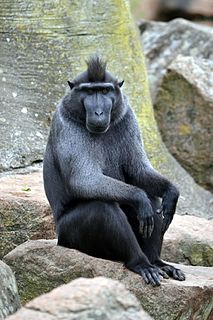 W
WThe Celebes crested macaque, also known as the crested black macaque, Sulawesi crested macaque, or the black ape, is an Old World monkey that lives in the Tangkoko reserve in the northeastern tip of the Indonesian island of Sulawesi (Celebes), as well as on smaller neighboring islands.
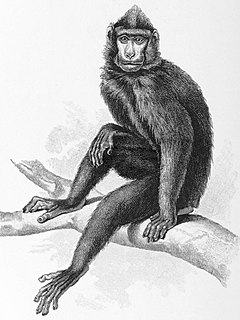 W
WThe Gorontalo macaque or Dumoga-bone macaque is a species of primate in the family Cercopithecidae. It is endemic to the island of Sulawesi in Indonesia.
 W
WThe Heck's macaque is a macaque of Sulawesi, Indonesia. This Old World monkey is diurnal.
 W
WThe moor macaque is a macaque with brown/black body fur with a pale rump patch and pink bare skin on the rump. It is about 50–58.5 cm long, and eats figs, bamboo seeds, buds, sprouts, invertebrates and cereals in tropical rainforests. It is sometimes called "dog-ape" because of its dog-like muzzle, although it is no more closely related to apes than any other Old World monkey is. It is endemic to the island of Sulawesi in Indonesia.
 W
WThe Makassar tarsier is a species of tarsier. Its range is in Indonesia in the southwestern peninsula of the island of Sulawesi, near Makassar. At one point the taxon was downgraded to a junior synonym of the spectral tarsier. However, when that species' range was restricted to the population on a single island near Sulawesi, this nomen was resurrected to contain the remainder of that species.
 W
WThe Manado fruit bat is a species of megabat in the family Pteropodidae.
 W
WThe minute fruit bat (Cynopterus minutus) is a species of megabat within the family Pteropodidae. It is found in Sumatra, Java, Borneo and Sulawesi.
 W
WThe North Sulawesi babirusa is a pig-like animal native to Sulawesi and some nearby islands in Indonesia. It has two pairs of large tusks composed of enlarged canine teeth. The upper canines penetrate the top of the snout, curving back toward the forehead. The North Sulawesi babirusa is threatened from hunting and deforestation.
 W
WThe Sulawesi rousette is a species of megabat in the family Pteropodidae endemic to Sulawesi, an island in Indonesia.
 W
WThe spectral tarsier is a species of tarsier found on the island of Selayar in Indonesia. It is apparently less specialized than the Philippine tarsier or Horsfield's tarsier; for example, it lacks adhesive toes. It is the type species for the genus Tarsius. While its range used to also include the population on nearby southwestern Sulawesi, this population has been reclassified as a separate species, Tarsius fuscus. Some of the earlier research published on Tarsius spectrum refers to the taxon that was recently reclassified and elevated to a separate species, the Gursky's spectral tarsier .
 W
WThe Sulawesi bear cuscus or Sulawesi bear phalanger is a species of arboreal marsupial in the family Phalangeridae endemic to Sulawesi and nearby islands in Indonesia. It lives in tropical moist lowland forest at elevations up to 600 m and is diurnal, folivorous and often found in pairs. A. ursinus is threatened by hunting, collection for the pet trade and deforestation.
 W
WThe Sulawesi dwarf cuscus is a species of arboreal marsupial in the family Phalangeridae endemic to Sulawesi and nearby islands in Indonesia. It inhabits tropical moist lowland forest and is nocturnal, folivorous and usually found in pairs. S. celebensis is threatened by hunting and deforestation.
 W
WThe Sulawesi flying fox or Sulawesi fruit bat is a species of megabat endemic to Indonesia. It is classified as "Vulnerable" by the IUCN due to unsustainable levels of hunting.
 W
WThe Sulawesi free-tailed bat is a species of bat in the family Molossidae. It is found in Indonesia and the Philippines.
 W
WThe Sulawesi harpy fruit bat is a species of megabat in the family Pteropodidae. It is endemic to Indonesia."This species occurs in Sulawesi, Indonesia. It is also found in Soloi on Buton island in Indonesia. It occurs from sea level up to 2,120m asl or probably higher. This species is not common. In 2002, three individuals were captured at a single locality. Population Trend ↓ Decreasing. It seems to require good forest, but has also been recorded from cocoa plantations. Soloi individuals were caught over a river in undisturbed forest. Roosting habits are not known, but this species is not likely to be a cave dweller. Hunting for sale at market, and forest loss due to expanding agriculture and logging represent major threats to this species. This species is known to occur in Domoga-bone National Park."
 W
WThe Sulawesi horseshoe bat is a species of bat in the family Rhinolophidae. It is endemic to Indonesia.
 W
WThe Sulawesi naked-backed fruit bat is a species of megabat in the family Pteropodidae. It is endemic to Indonesia.
 W
WThe Sulawesi shrew is a species of mammal in the family Soricidae. It is endemic to the central and northern provinces of Sulawesi in Indonesia. It is a fairly common species and the International Union for Conservation of Nature has assessed its conservation status as being of "least concern".
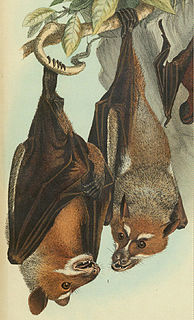 W
WThe Wallace's or Sulawesi stripe-faced fruit bat is a species of megabat in the family Pteropodidae. It is endemic to Sulawesi and the nearby Togian Islands of Indonesia. Cave paintings resembling these bats have been found in Australia, where bats of this kind are not otherwise known.
 W
WThe Sulawesi tiny shrew is a species of mammal in the family Soricidae. It is endemic to the island of Sulawesi in Indonesia.
 W
WThe Sulawesi white-handed shrew or Temboan shrew is a species of mammal in the family Soricidae. It is endemic to the island of Sulawesi in Indonesia. It is a fairly common species and the population seems stable so the International Union for Conservation of Nature has assessed its conservation status as being of "least concern".
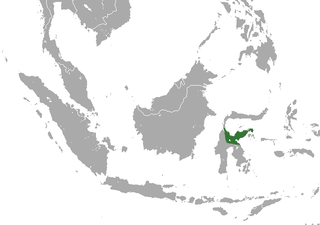 W
WDian's tarsier, also known as the Diana tarsier, is a nocturnal primate endemic to central Sulawesi, Indonesia. Its head-body length is 11.5–12 centimetres (4.5–4.7 in) and it has a tail of 22 centimetres (8.7 in). Dian's tarsier lives in rainforests. It was formerly called T. dianae, but that has been shown to be a junior synonym.
 W
WThe Lariang tarsier is a recently described tarsier occurring in the western part of the central core of Sulawesi. Six museum specimens of this species are known, two of which have been misidentified as the pygmy tarsier before their correct identity came out. This species has been named after the Lariang River, an important river in the part of Sulawesi where this species occurs.
 W
WThe Peleng tarsier, or the Peleng Island tarsier, is a nocturnal primate found on the island of Peleng, just east of Sulawesi, Indonesia.
 W
WThe pygmy tarsier, also known as the mountain tarsier or the lesser spectral tarsier, is a nocturnal primate found in central Sulawesi, Indonesia, in an area with lower vegetative species diversity than the lowland tropical forests. The pygmy tarsier was believed to have become extinct in the early 20th century. Then, in 2000, Indonesian scientists accidentally killed one while trapping rats. The first pygmy tarsiers seen alive since the 1920s were found by a research team led by Dr. Sharon Gursky and Ph.D. student Nanda Grow from Texas A&M University on Mount Rore Katimbo in Lore Lindu National Park in August 2008. The two males and single female were captured using nets, and were radio collared to track their movements. As the first live pygmy tarsiers seen in 80-plus years, these captures dispelled the belief among some primatologists that the species was extinct.
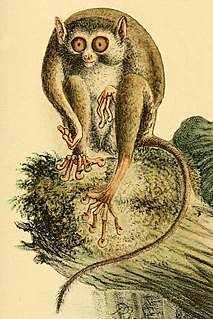 W
WThe Sangihe tarsier, also known as Sangihe Island tarsier, is a small primate found on Sangir Island, which is located about 200 kilometers north-east of the island of Sulawesi in Indonesia. In 2008 a population of the Sangihe tarsier was determined to be a distinct species, the Siau Island tarsier.
 W
WThe Siau Island tarsier is a species of tarsier from the tiny volcanic island of Siau.
 W
WThe Gursky’s spectral tarsier is a species of tarsier found in the island of Sulawesi in Indonesia. A recent taxonomic revision, split this species off from the spectral tarsier and other tarsier species based on difference in vocalisations and pelage.
 W
WThe Togian babirusa, also known as the Malenge babirusa, is the largest species of babirusa. It is endemic to the Togian Islands of Indonesia, but was considered a subspecies of Babyrousa babyrussa until 2002. Compared to the better-known north Sulawesi babirusa, the Togian babirusa is larger, has a well-developed tail-tuft, and the upper canines of the male are relatively "short, slender, rotated forwards, and always converge".